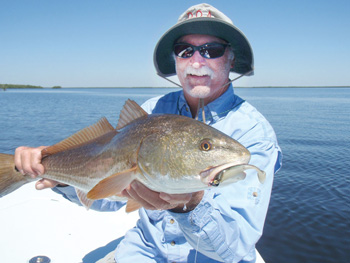The jig is up - the world’s best lure

Rusty Chinnis | submitted
DOA inventor and fishing guru Captain Mark Nichols
holds a redfish he caught with his CAL jig. The CAL is one
of the leading jigs on the market today.
Of all the lures in existence the jig would have to be my number one pick. The jig is one of the oldest and most productive lures known to man. With the plethora of modern computer designed lures, holographic patterns and life-like action, this simple design remains one of the top producing lures in an angler’s tackle box. If you have faith and vary the action, it's possible to elicit a strike from any game fish (fresh or salt) that swims local waters.
Jigs are often used half-heartedly by anglers who substitute them for live bait. Take the time to really give them a chance, and you’ll find that they will often out perform live bait. This may be hard to believe, but consider the facts. You gain an advantage by not having to catch or keep live bait. In addition you don't have to constantly re-bait a hook, replacing dead or lifeless baits. The jig can be cast and retrieved continuously, covering a greater area than live bait.
When fishing a jig, the basic (and most productive) presentation is made by allowing the lure to sink completely to the bottom. Using a slow retrieve, bounce the jig across the bottom. This method is effective for a large majority of species including trout, redfish, grouper, tarpon, flounder and snook. A fast, jerky retrieve will produce better results on Spanish mackerel, jacks and ladyfish. When fished properly, the retrieve should be smooth and effortless. Hold the rod at about a 45-degree angle to the water, imparting action with the wrist and forearm. Don't allow much slack to form on the retrieve, as most strikes happen on the drop.
At first, watch the line closely and you’ll get a visual cue that the jig is on the bottom when the line goes slack. With practice, the retrieve will become second nature. Since you’ll get lots of hits on the slack line fall, a sharp hook will greatly improve your odds. Sharpen your hooks before you start fishing and check them often. They’ll often get dull while jigging over rock and oyster beds.
Once you’ve mastered the basic presentation, pick the area you intend to fish. Grass beds that carpet the bays are an excellent place to begin. These areas can be accessed by boat or by wading from shore. Make repeated casts in a 180-degree arc with about 10 feet between casts. This will allow you to cover a lot of water. Make casts to sand holes and the edges of slues. Cast beyond holes and then let the jig bounce across the sandy bottom. Start at one end of the hole in the grass and then make the same spaced casts across its width to completely cover the pot hole. On the edges of grass flats and slues try casting parallel to and just off the grass edge.
Another excellent area to fish jigs is along the beaches. Work them from the outer edges of the first slue to the surf line. Since there are few obstructions, make sure they hit the bottom. Species like flounder, permit and pompano often key in on the puffs of sand the jig produces. When you find obstructions such as limestone, rock groins or jetties, work the edges carefully.
Basic spinning or bait casting outfits should have a tip that telegraphs a subtle strike and enough backbone to set the hook. Jigs will take 100-pound tarpon, 20-pound snook or two-pound trout, so line and leader will be rigged accordingly. For general use in the bay an 8-10 pound outfit (provided you have a smooth, properly set drag) is sufficient. Learn to tie a Bimini Twist or Spider Hitch to double your standing line and then attach a leader (20-30 pound) using a Surgeon’s or Uni-Knot. A small swivel can also be used to make the attachment from standing line to leader. Attaching the leader to the jig with a loop knot will improve the action and the hook-up ratio. The non-slip mono loop is the best knot for the job.
Like other lures, there are a vast number of jig types to choose from. It’s my opinion that most of the lures today are designed to catch the angler as much as the fish. The first jigs were made with lead heads and colored bucktail. They’re still on the market and some expert anglers still use them exclusively. A relative newcomer to the scene is the plastic tail jig. This variety allows the angler to change the tails color or shape. The newest innovations have added scent to the tails to attract fish. Scientists have discovered that fish can better locate darker colors in cloudy water and a light or clear color in clear water. Tailor the color of the jig to that of the water.
If you haven’t discovered the “magic” of jigs it’s time to give them a try. Any local tackle shop will have a mind-bending variety, so don’t be afraid to ask for some advice. Try the latest and greatest inventions, but also a few of the basic lead heads with bucktail. Give them a chance and you’ll find them efficient, inexpensive, and very effective.

